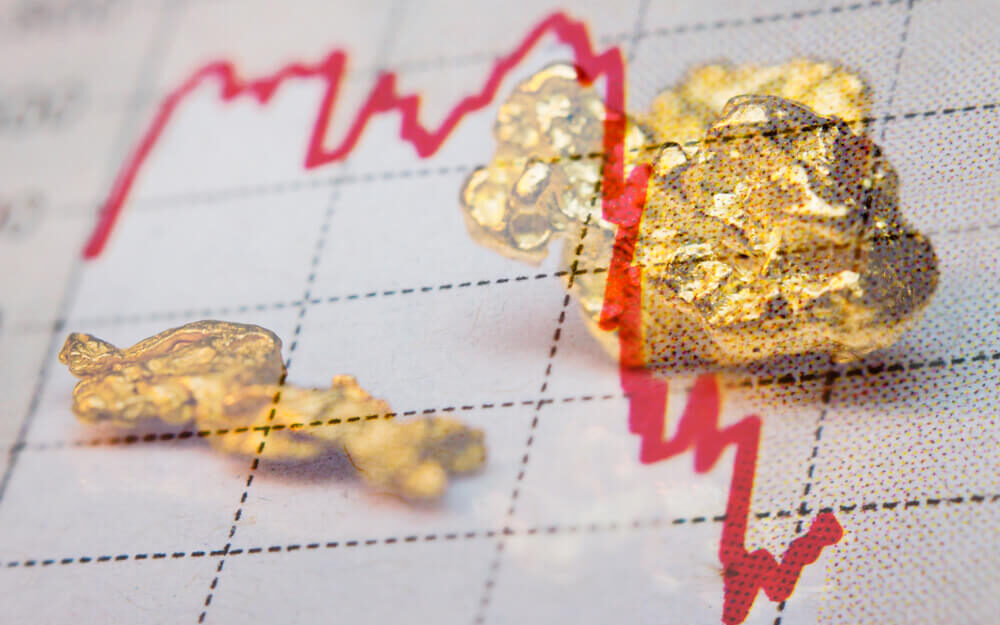When markets turned lower, investors used to run to gold.
But the yellow metal’s recent declines signal an important development for anyone seeking a hedge.
Let’s dive into gold in this week’s Investing With Charles. Research Analyst Matt Clark and I will show you why the gold price is dropping, pit different gold investing avenues against each other and tell you what my ideal gold portfolio allocation is.
Here are some highlights from my conversation with Matt.
Why Gold?
Charles: John Maynard Keynes called it a “barbarous relic.” Warren Buffett’s had quite a few jokes about gold. He said: “In what world does it make sense to spend a fortune digging this thing out of the ground only to melt it into little bars and then rebury it in a vault? Does that really make sense?”
Of course, when you look at it like that, it is a bit silly. But the reason gold even still exists as an asset class is that it is less correlated to other asset classes.
This gets down to the basics of how you build a portfolio.
I’m the dividend guy around here. But if you’re building a more comprehensive portfolio, you need to be diversified.
Having some shares of Microsoft and Apple … that’s not diversification because those two stocks tend to move close together. You need to have different asset classes that don’t move together.
That’s where gold fits in.
Not every month or every quarter, but over longer time horizons, gold has been a pretty good inflation hedge. That’s why you include it in the portfolio.
In the 1970s, which was before our time as investors, it was rough to be in bonds or stocks. But it was a fantastic time to be in commodities.
If your portfolio was balanced, you might have taken some pain in your stocks and bonds, but you were making some money in the commodities that helped smooth it out.
That’s the key. Have eggs in different baskets and make sure those baskets aren’t all in the same truck that’s at risk of crashing.
Why Gold Is Crashing With the Rest of the Market
Matt: Here’s a chart that shows how gold has performed on an ounce-cost basis over the last 12 months:
As we can see, it reached a high of a little over $2,000 per ounce in March. But since then, it has dropped around 12%. It's priced now at just above $1,800 per ounce, lower than it was 12 months ago.
What does that tell you?
Charles: A couple of things. One important caveat here: I don't subscribe to the view that "the price is right at all times" in markets.
If that were true, then no one would ever make money in it.
Obviously, the market is prone to overshooting either way. We’ve seen that a bit with the price of gold. It got a little bit too expensive in 2020 and then it has corrected off and on since then.
There‘s another takeaway from that. The Fed has insisted that inflation would be “transitory.” The action and the price of gold suggests that may be true.
If the market did think that inflation was going to stick around and be endemic like the 1960s or ’70s style of perpetual inflation that you can't stamp out, then I don't think you would see the price of gold correcting like this.
You see some confirmation of this in the bond market. Bond yields spiked earlier this year, but they've stopped. They've leveled out for now.
Again, the market is not this all-knowing deity, but I think it’s pricing in that inflation will fall in the coming months. I think that's what we're seeing here.
How to Diversify With Gold
Matt: Gold investing comes in a lot of different forms. You can buy bullion, bars or coins. There's also ways that you can invest in gold using exchange-traded funds (ETFs).
What in your mind is the best way to start to diversify that portfolio and use gold as a potential hedge here?
Charles: It depends on a couple of things. It depends on how long you intend to hold it, what your etiology (or cause) is and perhaps tax considerations.
Personally, I think it's just fine to own gold via an ETF. I prefer the ETFs that own underlying gold bullion because that's the asset class you want.
There are some products that trade in gold futures, but that's a different product. There is a timing component there and, if you're wanting pure exposure to the yellow metal, then getting one of the ETFs that actually holds underlying bullion is the best way to do it.
Some people might argue that: "Look, if gold is a crisis hedge against everything just blowing up, then you don't want to have it in the financial system. You'd rather have some gold coins or some bars buried in your backyard."
That's getting a little bit ideological.
The way I look at it: If things ever got that bad, then your gold's not going to be worth anything either. The only currency that matters, at that point, are canned goods and shotgun shells.
In the real world that we all have to live in, I'd say the ETF route is fine, particularly now since the cost of holding those ETFs falls by the day. Some of these have expense ratios of 14 basis points. It's very, very inexpensive to hold them.
There are costs to holding actual bullion. It's not as liquid a market as ETFs. If you go to a coin store, there‘s a spread between the bid price and the ask price, and you pay for that.
Beyond that, there are security considerations. If you own a bunch of gold in your house, and people know, you are at risk of theft. Owning it in a brokerage account or an IRA is easy. That's the path of least resistance. Yeah, that's what I would do.
How Much Should You Own?
Matt: How much gold should someone own as a percentage of their portfolio?
Charles: Keep it simple. Put something like 3% to 5% in gold.
If you're really worried about inflation, then maybe go as high as 10%. But I wouldn't go much higher than that.
At some point, you can have too much of a good thing.
Matt: Here’s the underlying message: With these market conditions and inflation, diversification is key.
We're not talking about just diversifying the type of stocks that you have in your portfolio, but diversifying into different asset classes.
Gold is still viable, regardless of its price drop of late.
Charles: That's just it. If you're following an asset allocation model and you always want to have something like 3% to 5%, you have your criteria to rebalance.
If you want 5%, and it drops to only 2% or 3% of your portfolio, then you buy more and rebalance.
Or if you have some gold, and it rips higher to 10% of your portfolio, take your profits. Sell it back down to your model. Buy low and you sell high, all the time.
In my view, that's where gold has real long-term value.
Shorter term? Yeah, just speculate it and have fun. There's nothing wrong with trading. We do it all the time.
But when you're looking at that long-term portfolio, that's where gold is most viable.
Where to Find Us
Coming up this week, Matt will have more on The Bull & The Bear podcast, so stay tuned.  Don't forget to check out our Ask Adam Anything video series, where Chief Investment Strategist Adam O’Dell answers your questions.
Don't forget to check out our Ask Adam Anything video series, where Chief Investment Strategist Adam O’Dell answers your questions.
You can also catch Matt every week on his Marijuana Market Update. If you are into cannabis investing, you don’t want to miss his weekly insights.
Remember, you can email my team and me at Feedback@MoneyandMarkets.com — or leave a comment on YouTube. We love to hear from you! We may even feature your question or comment in a future edition of Investing With Charles.
To safe profits,
Charles Sizemore, Co-Editor, Green Zone Fortunes
Charles Sizemore is the co-editor of Green Zone Fortunes and specializes in income and retirement topics. He is also a frequent guest on CNBC, Bloomberg and Fox Business.






